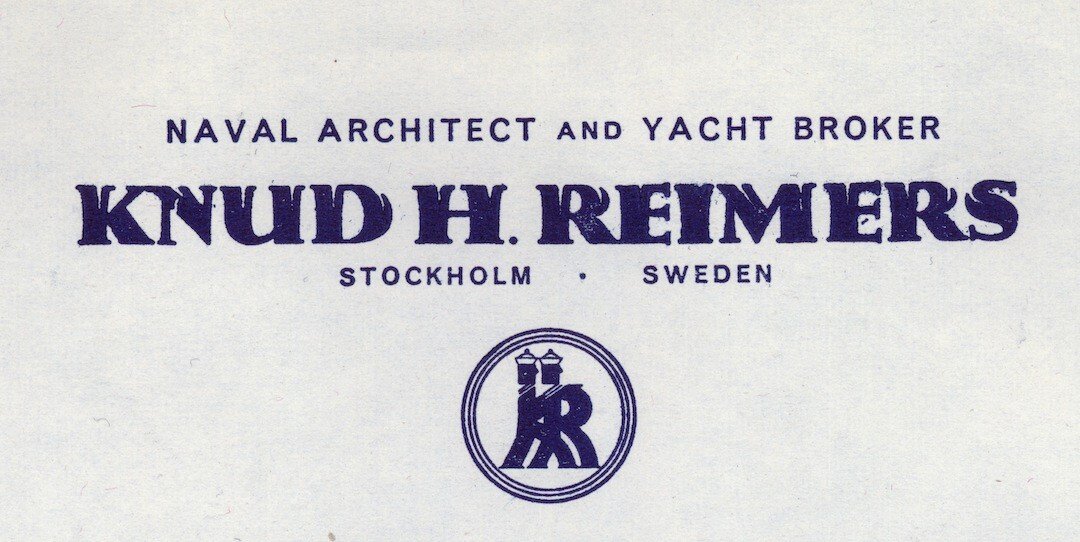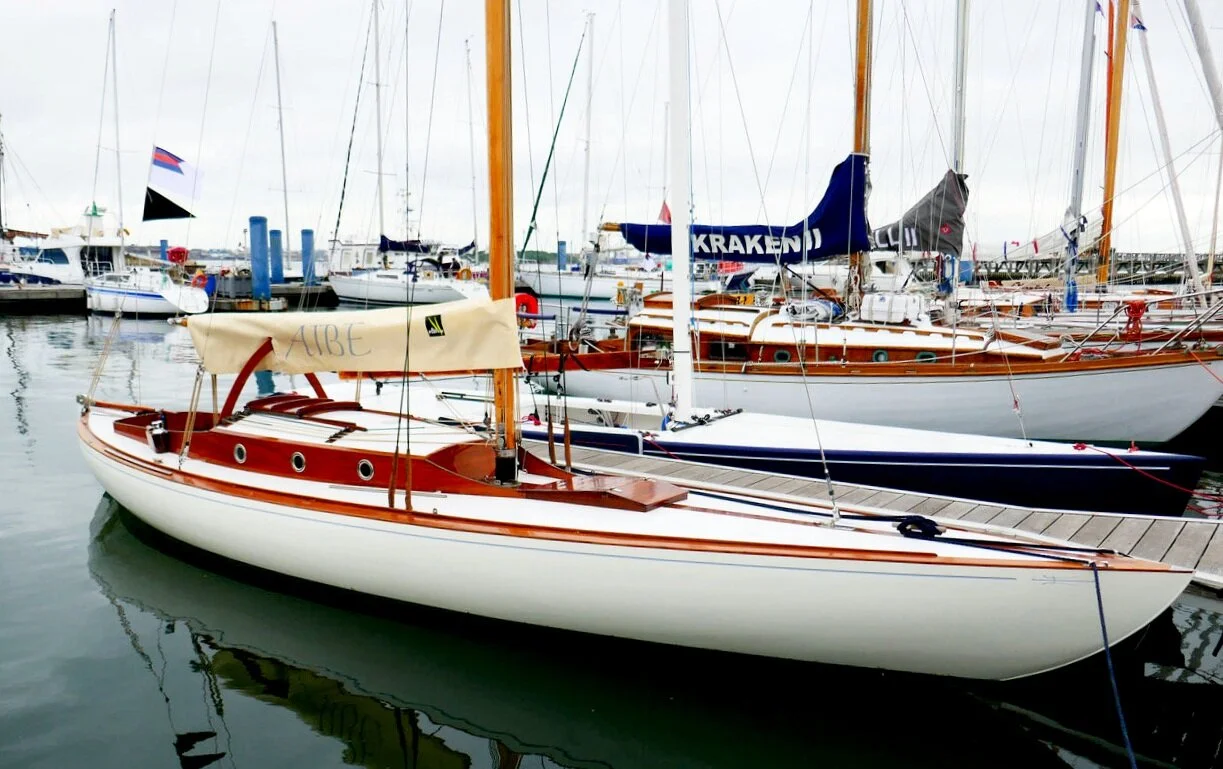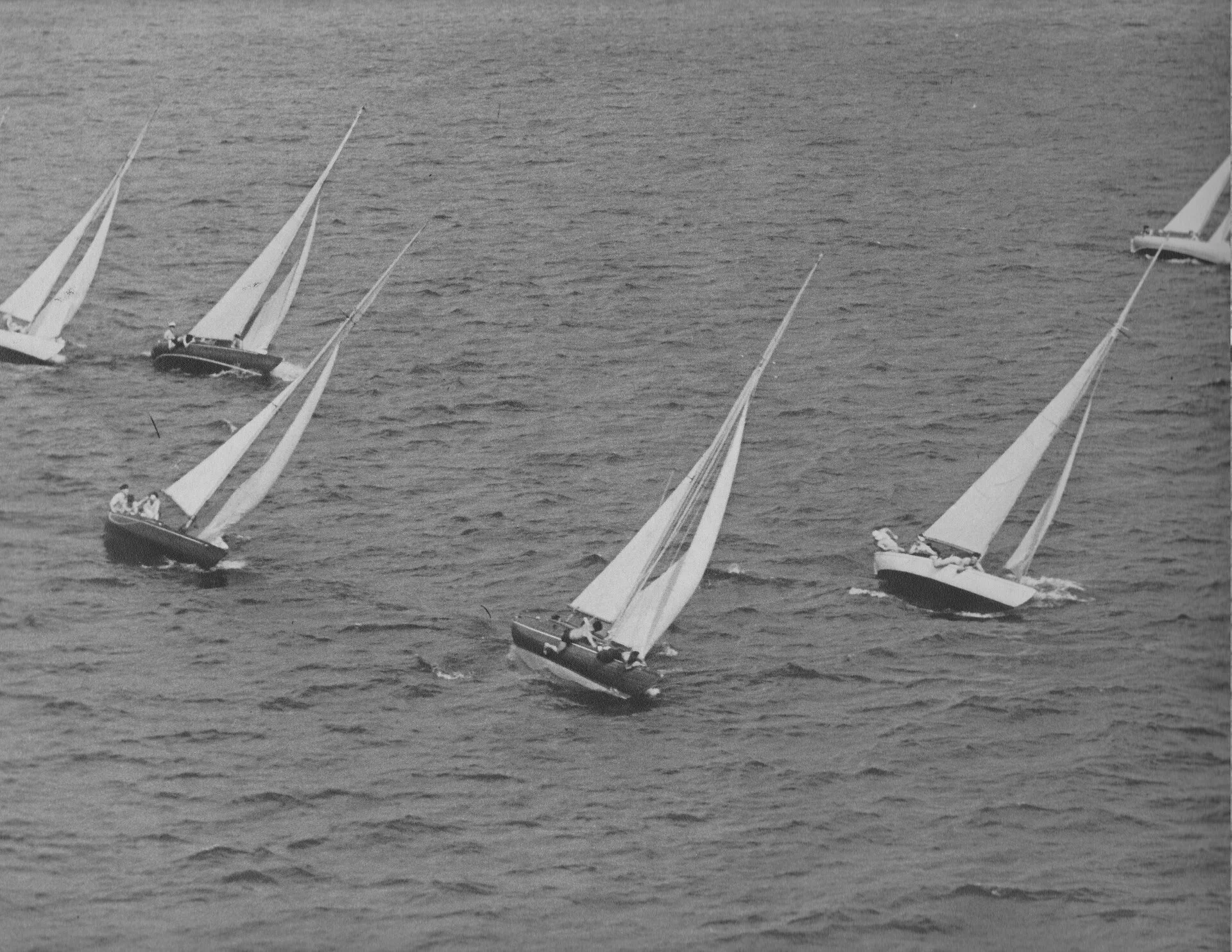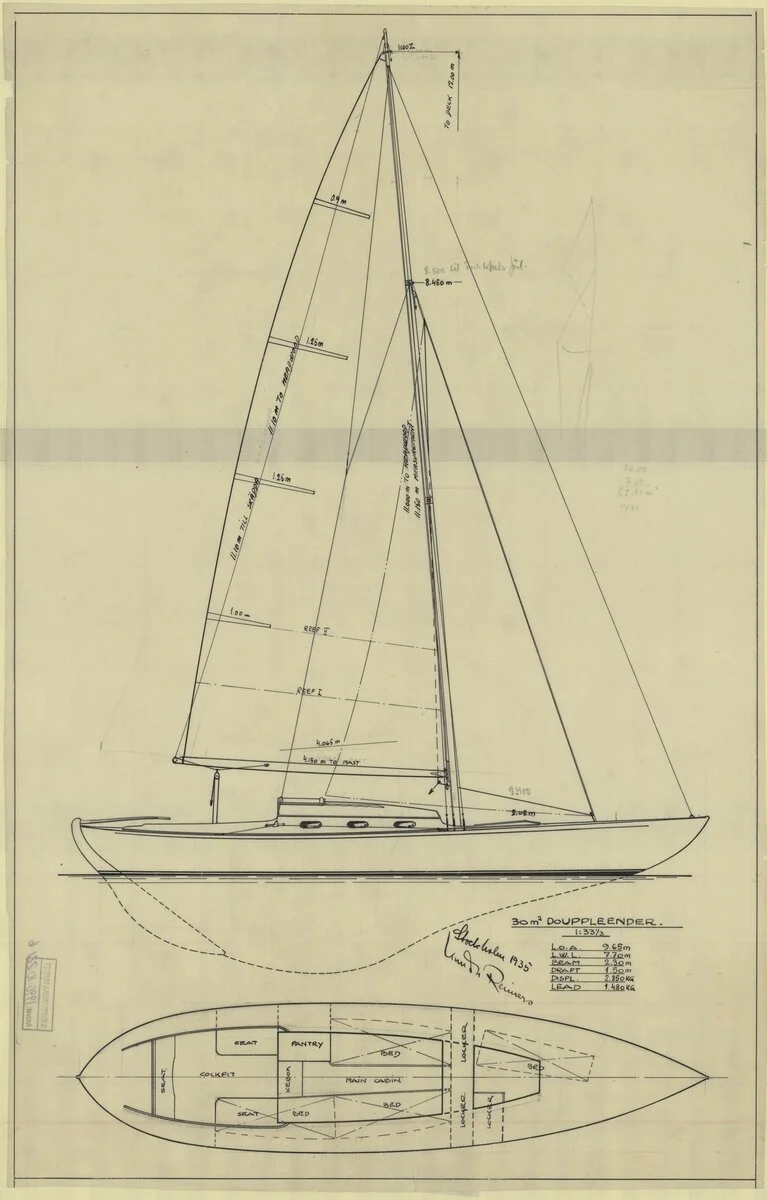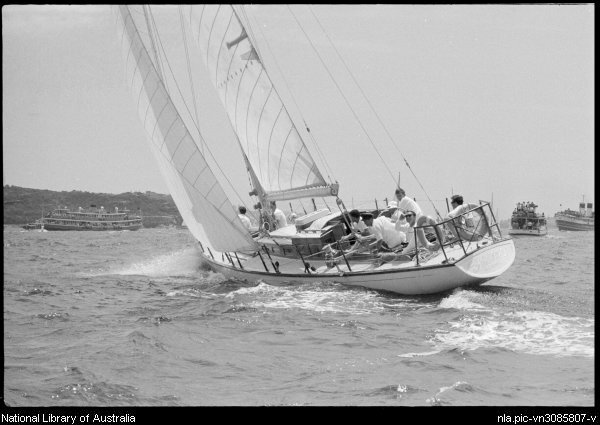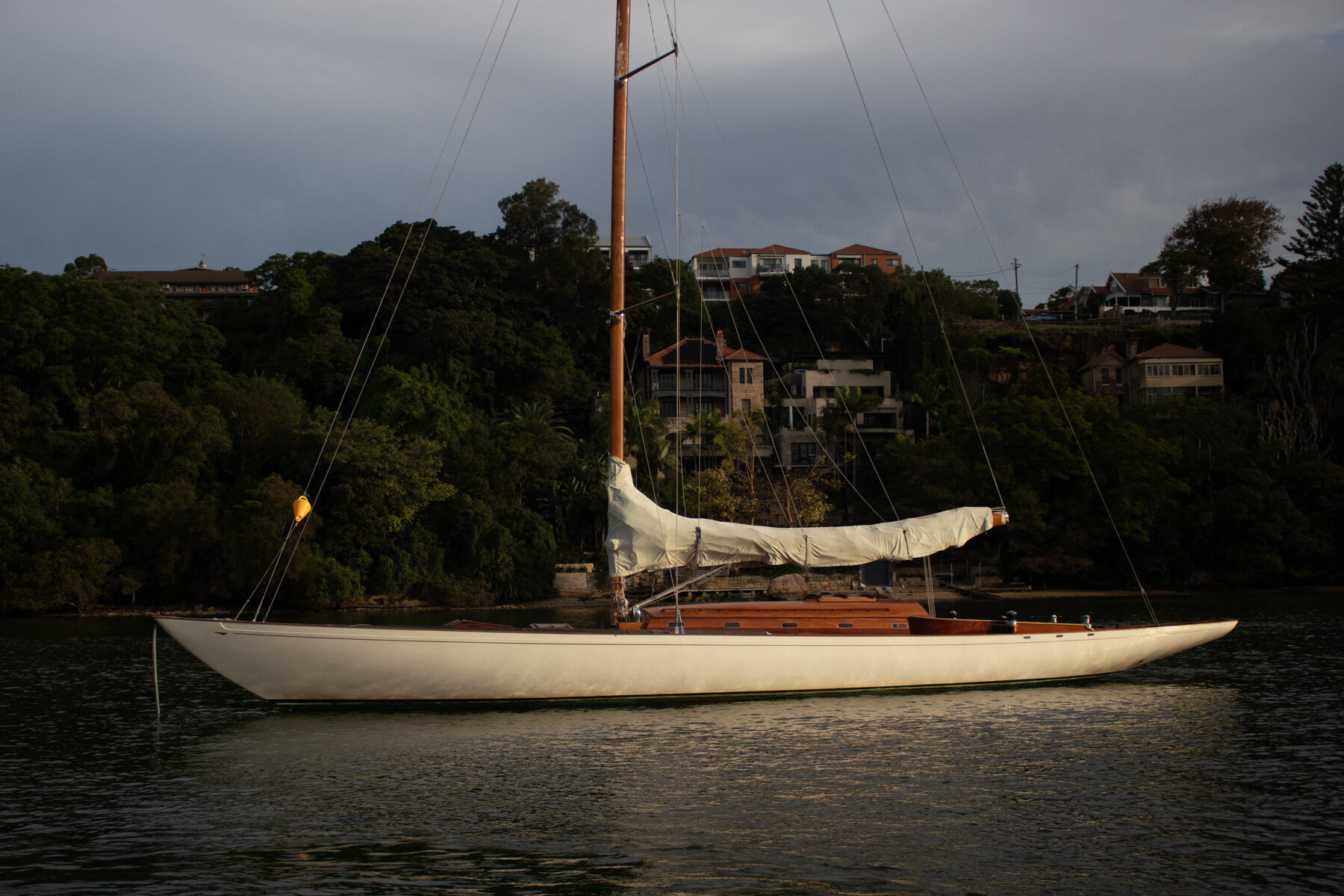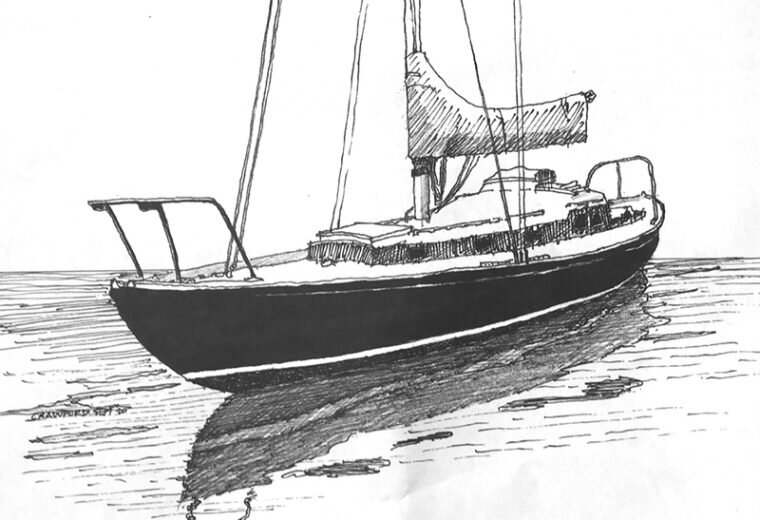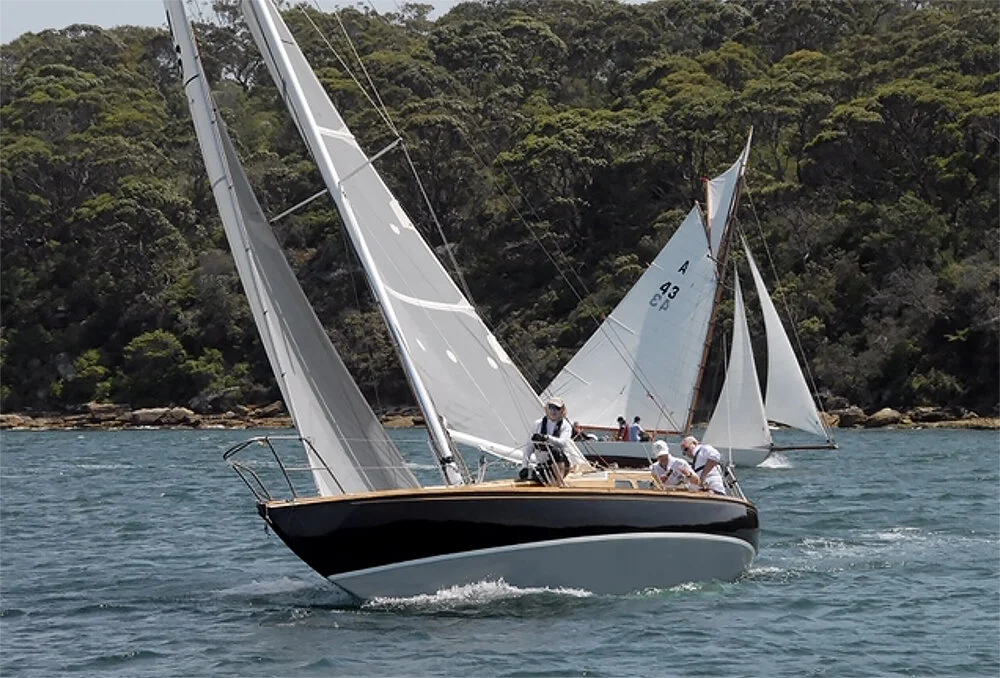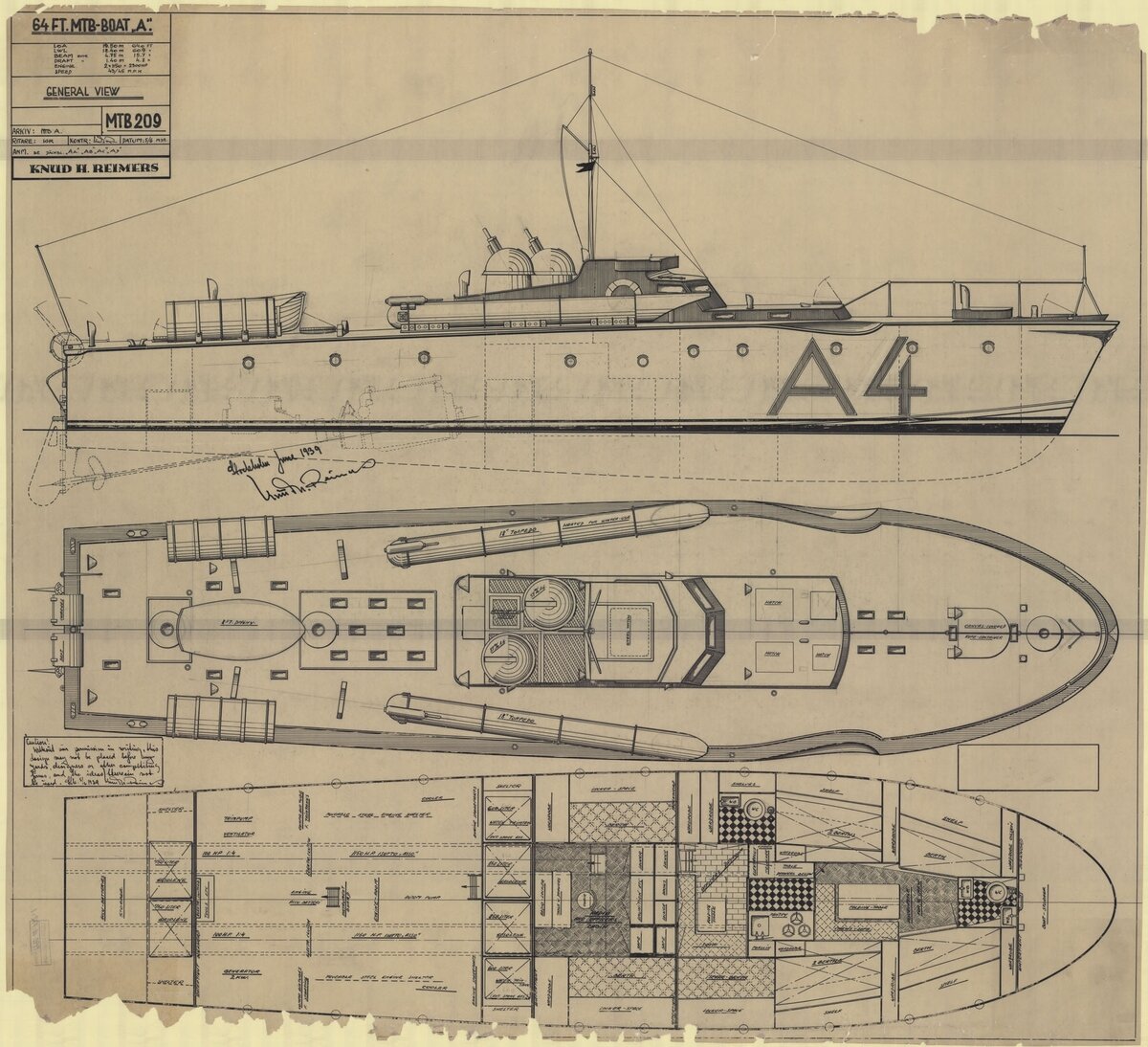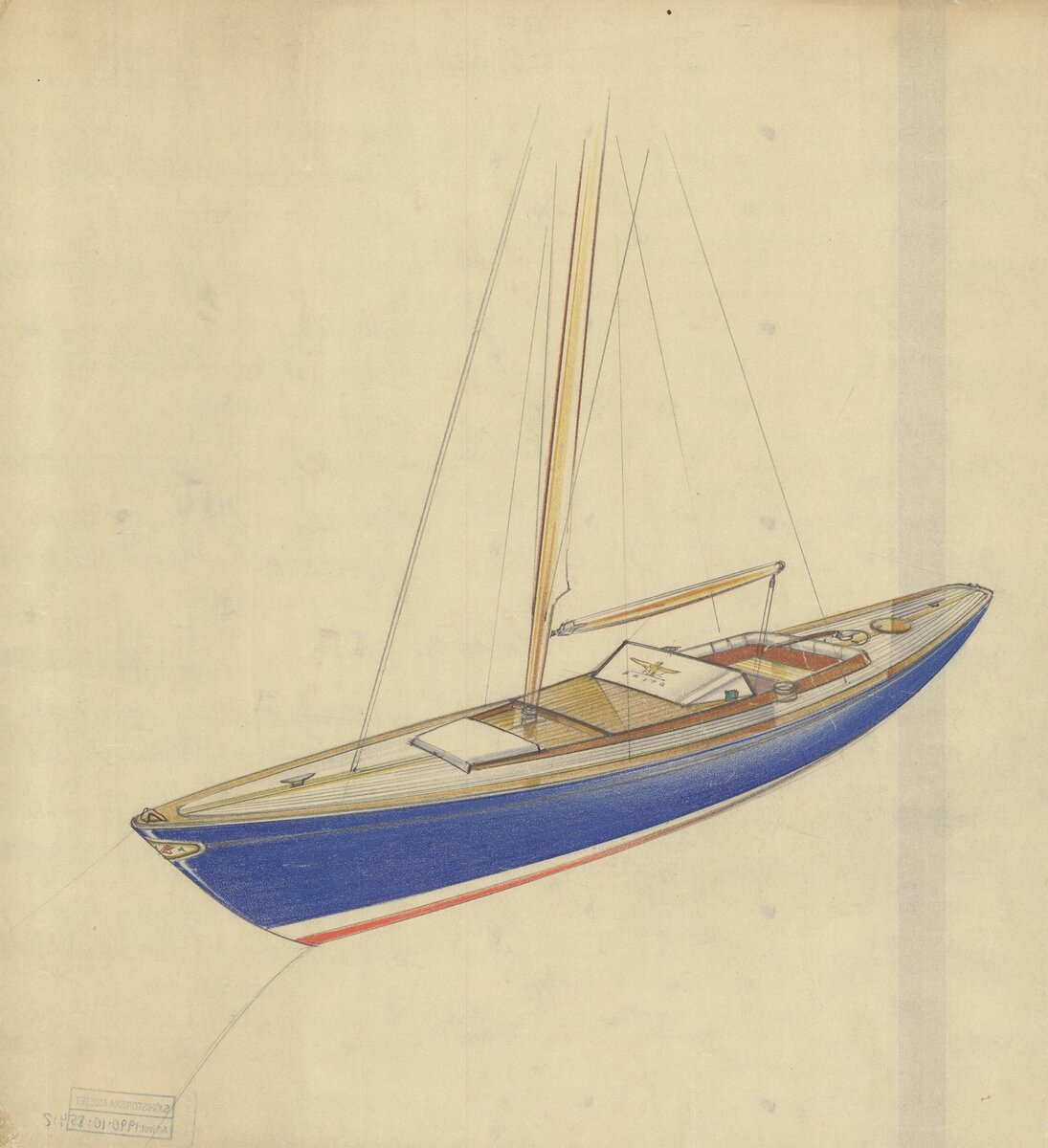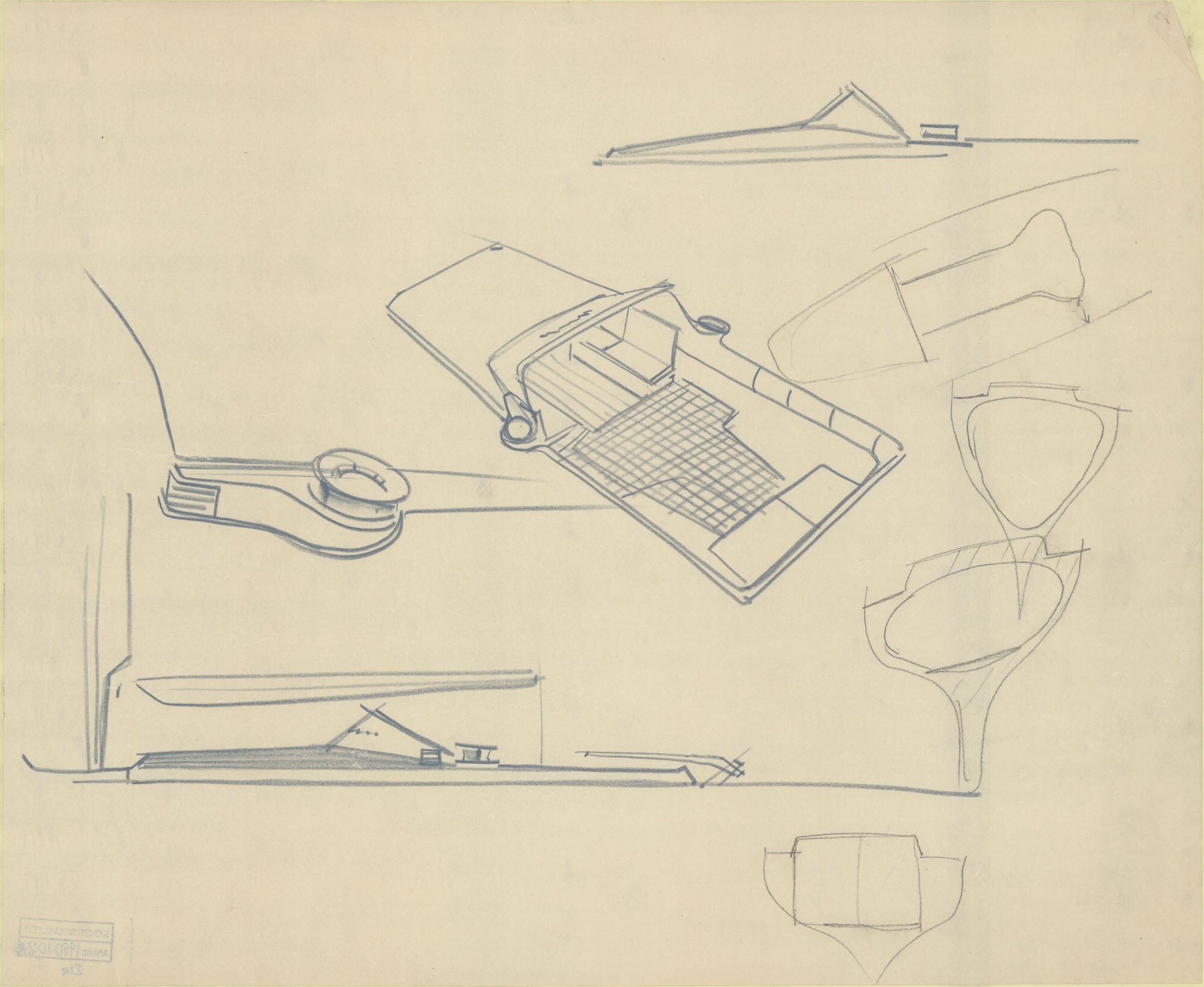Who is Knud Reimers?
Most sailors know Knud Reimers’ Tumlaren, sailed in Australia since 1937. it’s just one in a folio of successful designs over six decades. Here’s a look at Reimers and his boats.
There was a terrific response from the Tumlaren community to the Southern Wooden Boat Sailing interview last week - YVONNE, A SMALL SYNDICATE HANDS ON RESTORATION, SWS 12th August. Martin Olsen in Denmark kindly put us in touch with Teodor Reimers, the grandson of Knud Reimers. Barbara Joyce, Selim Nurminen’s daughter, added a few personal notes to the story and 80 years young instagramer Joan Doiron, sent signals from Vancouver Island. Joan is the daughter of Al Rae, the champion Tumlaren sailor in the 1940’s and 50’s at the Queen City YC in Toronto.
TUMLAREN #1 AIBE 1934
KNUD H REIMERS
Knud Hjelmberg Reimers was born in Aarhus Denmark in 1906 and educated as a shipwright and designer in Germany. He started at Krupp-Germania Werft in Kiel building large sailing and motor yachts. He then attended technical college while apprenticed to Abeking & Rasmussen in Bremen. Krupp are better known for their U-Boats while in the 1920’s Henry Rasmussen was designing fast 12m racing yachts that sold in Europe and the US. In 1930 Reimers found his first studio job in Stockholm with the Finnish architect and yacht designer GUSTAF ESTLANDER at SWS 5th March 2020. Estlander was an established designer of fast and radical 20 and 30 square metre Skargardskryssare (Skerry Cruisers). In 1931 aged 25, Reimers took over the studio when Estlander died suddenly.
KNUD REIMERS on an INTERNATIONAL 5m. Photo OSCAR NORBERG 1937
Colorized by Frank Hellsten
The office of Knud H Reimers, Naval Architect & Yacht Broker was underway. The new circular “KR” studio logo seems inspired by the “AR” logo still used today by Abeking & Rasmussen. To anchor the finances, he was able to quickly sell six 22m skerry cruisers to the Detroit YC. The important Reimers yachts like the Tumlaren and Bacchant, were designed in this first decade. His open and inventive approach would constantly rework and refine these earlier successes throughout a career of 60 years. This ensured his yachts were competitive and contemporary as rules, materials and client requirements changed. Many of these yachts are still sailing in Australia.
Skargardskryssare
The 1925 Swedish Metre Rule fixed class sail area but allowed length, beam & displacement to be customised. This encouraged invention for speed & stability. Yachts with exaggerated aft overhangs and shorter double-enders (Spidsgatter) could be classed as 20, 30, 50, 60 or 70sq metre designs. A large overhang and long waterline produced speed, while tall narrow (high aspect) rigs picked up the steady breeze above the Scandinavian islands & rock outcrops. The designs, mostly with low freeboard also had to be stable in the open Baltic Sea. A typical Reimers 22sq design would be a pencil of 38-40’ LOA, a 6’ beam and light 1.75ton displacement. The design fundamentals of the Skargardskryssare (Skerry Cruiser) are embedded in most Reimers yachts. The Skerrys are still sailed on the European and American Great Lakes also around the Scandinavian archipelagos.
The 22sq VINST was designed by Reimers and built by Rotholmens in Stockholm in 1941. Her dimensions are 42’ LOA with 26’ LWL and 6’, 2” beam. In 1950 she was sold and shipped to the Chicago Yacht Club on Lake Michigan ….and now for sale via Rockport Marine in Maine if you have a spare USD95,000.
KNUD REIMERS 22sq SKERRY CRUISER 1936
KNUD REIMERS 22sq SKERRY “VINST”. PHOTO OSCAR NORBERG 1941
INT 5m & 6m YACHTS
Steady orders for Skerry’s and the very competitive International 5 and 6m classes underpinned the Reimers studio in the 1930’s. These were popular yachts in Europe before the war, merging into the 5.5m Olympic class at Helsinki in 1952. Reimers produced many versions with split racing cockpits and cruising cabs.
KNUD REIMERS 5m YACHT 1936
5m LAKE SAILING WITH SHY BALLOON SPINNAKERS
TUMLAREN
By 1933, Reimers was designing boats that made his name. The 20sq, 27ft Tumlare(n) was a success from the beginning. Licenses for this unique double-ended cruiser were sold to establish fleets in England, on the Great Lakes at Chicago, Detroit & Toronto and the St Kilda Yacht Club in Melbourne in 1937.
MELBOURNE’s TUMLAREN FLEET in the 1970’s. Photo ELIZABETH HARDING
TORONTO’s TUMLAREN FLEET at QUEEN CITY YC 1944. Photo QCYC ARCHIVE
“Stories abound of Tumlaren fighting through conditions that sent many other boats running for shelter”. Rather than repeat grand claims for this beautifully balanced boat, we recommend a terrific article in the Classic Yacht Association of Australia magazine from 1998, TUMLAREN - A Classic Class by Damien Purcell.
KNUD REIMERS TUMLAREN DRAWING 1937
KNUD REIMERS TUMLAREN DRAWING 1937
TUMLAREN HOCCO
Reimers was happy to make adaptions to the Tumlaren. In 1934 sailors from Lake Geneva asked for an increased sail area suited to the lighter conditions of inland sailing. A Tumlaren carries 220sq ft of sail while the Swiss variation named Hocco, added another 80sq ft. Reimers increased the geneo overlap and extended the boom and mainsail foot by 58cm . The mast and mainsail luff heights were unchanged. The Hocco AMADEUS below has bumkin dental work to hold the backstay clear of the leech.
The tradition of custom refinement and experiment was embedded in the office from Reimers experience with metre boat design. Similarly in the late 1940’s and after resistance from the one-design Tumlaren Association Trustees, the Australian fleet stripped the original cruiser fit-out to make a day-sailor. Reimers no doubt would have supported that idea as “fit for purpose” on Port Phillip Bay.
KNUD REIMERS TUMLAREN HOCCO 1934
HOCCO “AMADEUS” LAKE GENEVA
STOR TUMLAREN
By 1935 Reimers was drawing the larger Stor Tumlaren aka Albatross (LOA 32’ & 7’ beam) compared to the Tumlare (LOA 27’, 3” & 6’, 3” beam). The extra dimensions made her a very comfortable and fast family cruiser. When raced by a Tumlaren master like Melbourne’s Doug Jenkin and family, they load up with a yankee jib and street the field. There are several nice examples of Stor Tumlaren in Australia like Jenkin’s Bluejacket in Williamstown and Skagerrak on Lake Macquarie NSW.
A modified Stor was made famous by K. Adlard Coles’ COHOE #339 in the 1950 Transatlantic race. COHOE was shipped to Newport with two other British yachts SAMUEL PEPYS and MOKOIA with plans to sail the Bermuda race and then the Transatlantic return race to Plymouth. In the first leg they all survived an ex-tropical cyclone with swells from two directions. Then from Bermuda it was wild downwind running in front of Atlantic storms. SAMUEL PEPYS took line honours and COHOE the handicap race. Coles started with publishing sailing magazines and expanded into nautical books. The race is recounted in Coles’ book “The North Atlantic”.
Photos of COHOE clearly show a pointy bow extension (like a prosthetic nose) added for the race and removed later according to Rob Evans of CELESTE (see below). The purpose, perhaps for race compliance, will no doubt be revealed.
KNUD REIMERS STOR TUMLAREN 1935
EARLY SWEDISH STOR TUMLAREN
KNUD REIMERS 34sq COHOE
COHOE SAILING off BERMUDA 1950
TUMLARTWO & TUMLAREN 84
A great design invites re-invention. Reimers re-worked the Tumlaren for 50 years. In 1962 he was drawing TumlarTwo a “300sq ft modern double ender”. In 1984, he was reworking the original 27’ Tumlaren as a fibeglass boat. A few inches added here & there alter the sheerline to create a more contemporary but still beautiful boat. This was never delivered as Reimers died in 1987.
TUMLAREN in FIBREGLASS 1984
BACCHANT & FIDELIS
Reimers designed the 75sq BACCHANT (LOA 64’ & 12’ beam) in 1936. She was built at August Plym’s Kummelnas shipyard near Stockholm for Eric Lundgren. From 1976 BACCHANT spent 37 years on Lake Michigan at the Milwaukee YC and was recently returned to Sweden. This is an important template design that Reimers continued to refine, producing race winning yachts like FIDELIS some 30 years later.
FIDELIS (LOA 61’ & 10’ beam) is a Bacchant built in Auckland in 1964 with triple skin kauri and a chopped stern. From the launch, she was a success winning the Auckland to Suva race and the 1966 Sydney Hobart in 4 days, 8hrs, 39min, a record time that stood for 9 years. Her nearest rival BALANDRA was 70Nm and 17 hours astern. FIDELIS is moored at Shell Cove and can still be seen racing on Sydney harbour.
KNUD REIMERS BACCHANT II
FIDELIS SYDNEY HOBART RACE START 1966
FIDELIS SYDNEY HOBART 1966
SISKA
The first of five SISKAS owned and skipped by Rolly Tasker was a Reimers boat. Tasker won the silver medal in the 12m2 Sharpie at the 1956 Melbourne Olympics and was Flying Dutchman world champion in 1958. SISKA is 40sq (LOA 50’ 6” & 8’ 6” beam) built in Sydney in 1939 and launched as HIAWATHA. Tasker modified the boat in 1966 and raced her successfully offshore. Like FIDELIS, these 1930’s Reimers designs were lightweight, long and easily driven requiring less sail area to go faster than boats being designed in the 1960’s. SISKA became the template for Reimers’ very successful SwedeSail 55 designed in 1975.
SISKA in 1969 SYDNEY HOBART. CYCA ARCHIVE PHOTO
SWEDESAIL 55 from 1975
AGNETA
AGNETA is an 82’ yawl built by Plym’s in Sweden in 1948 with varnished mahogany over oak frames. The wealthy hands-on FIAT owner, Gianni Agnelli could have owned any boat but chose to sail this Knud Reimers beauty for 25 years from 1954. She’s the length of 3 Tumlaren and named after Reimers daughter. Reimers devotees will recognise the simple drawing and classic sheer line. ”Vai Avvocato con velocita e stile”.
KNUD REIMERS DRAWING for 82’ YAWL (AGNETE)
AGNETA at ANCHOR in the MEDITERRANEAN
PLYM
Plym is a beautiful Reimers 58’ skerry cruiser also built by Plym’s Shipyard in 1945. Until recently, she was sailing in classic events on Sydney Harbour while kept uncovered on a swing mooring near Darling Point. Reports had been suggesting she’s not in the superb condition shown here in the 2017 sale photos. However, SWS noted Plym’s entry in the cancelled 2021 Hamilton Island Race Week in Queensland, scheduled for end August. This suggests a new owner has refurbished the yacht.
PLYM SYDNEY HARBOUR 2017
PLYM SYDNEY HARBOUR 2017
CELESTE
There’s another beautiful and fast Reimers yacht at Sydney Amateurs SC called CELESTE. The owner, PC Rob Evans has written a few notes (p.27 - 29) in a recent SASC Newsletter “The End of the Affair”. After a brief conversation with SWS this week, Rob reported his interest to sell can only be re-ignited by a very good price. After a few health issues he’s “come good” so skipper and boat are faster than ever.
CELESTE was launched in 1953. She looks Stor-ish but slightly bigger (LOA 32’, 8” & 6’, 8” beam) and is the result of long discussions between Reimers and the original Adelaide owner/builder Alan Jordan. She’s a double-ender with an inboard tiller/rudder set-up and an extended cab similar to COHOE and other well documented 30sq Reimers boats. Jordan used Queensland white beech on nickel alloy Monel frames to avoid corrosion. This follows Reimers’ original specification for the Tumlaren with steel ribs. When developing plans for CELESTE, Reimers could draw on 30 years of skerry and spidsgatter experience. Rob Evans restored CELESTE’s fractional rig and is able to sail very comfortably offshore in any weather using only light helm and two crew.
Note: The only Australian Tumlaren built with steel frames is #318 ZEPHYR (Zefir) launched in Adelaide in 1953. During the 1990’s rebuild the ribs were replaced with spotted gum.
SKETCH of CELESTE 1990
CELESTE off CREMORNE POINT SYDNEY HARBOUR
MOTORKRYSSARE
Motor cruisers were a staple output of the Reimers office. These boats are still prized in Scandinavia and have a following like Halvorsen in Sydney. The naval architecture practice was busy in the 1930’s with orders for racing, cruising and motor yachts but by 1939 things had changed even in neutral Sweden. Like many naval architects and shipyards, both Reimers and Halvorsen, turned their hands to designing auxiliary and military patrol boats to government commissions.
MOTORKRYSSARE HJORTEN (Deer) 1939
A HJORTEN MOTORKRYSSARE RECENTLY RESTORED
KNUD REIMERS 64’ MTB PATROL BOAT 1939
STUDIO SKETCHES
Reimers sketches demonstrate a fine drafting hand. The first drawing is the 1955 UDELL 22. It shows a stylishly slanted wind-cheater, smooth winch mounts and upholstered coaming with a single pencil line to set the bow reflection. The study for the cockpit shows Reimers is thinking about a keyhole cockpit from an International 5m, possible interior sections and a layout that predicts very smart day-sailors like the current crop of Leonardo Yachts. The third sketch shows boat speed with a relaxed & rakish skipper helming with finger-tips.
KNUD REIMERS SKETCH for UDELL 22 from 1955
STUDIES for UDELL 22 from 1955
KNUD REIMERS SPEED SKETCH
STUDIO LETTERHEAD
Even the Reimers studio letterhead didn’t escape his attention. With seawater draining off the topsides, the font displays the same level of detail as the drawings. Thats what happens sailing fast in a low freeboard skerry with lee gunwale down.
OKAND FOTOGRAF undated
CREDITS
Photos & drawings from the Reimers collection. Swedish Maritime Museum.
Captain of Classic our Swedish follower recently advised a book about Reimers is “in the making”.

